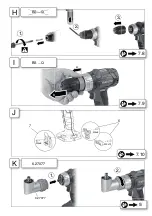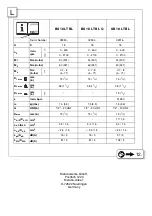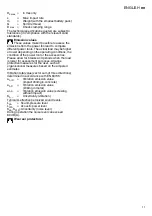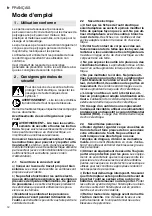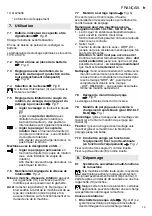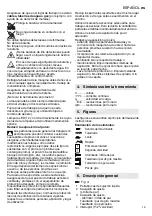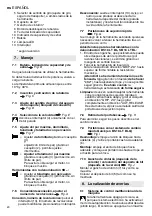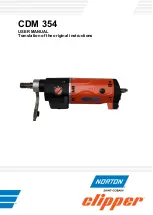
ENGLISH
en
8
c)
Disconnect the plug from the power source
and/or the battery pack from the power tool
before making any adjustments, changing
accessories, or storing power tools.
Such
preventive safety measures reduce the risk of
starting the power tool accidentally.
d)
Store idle power tools out of the reach of
children and do not allow persons unfamiliar
with the power tool or these instructions to
operate the power tool.
Power tools are
dangerous in the hands of untrained users.
e)
Maintain power tools. Check for misalign-
ment or binding of moving parts, breakage of
parts and any other condition that may affect
the power tool's operation. If damaged, have
the power tool repaired before use.
Many acci-
dents are caused by poorly maintained power tools.
f)
Keep cutting tools sharp and clean.
Properly
maintained cutting tools with sharp cutting edges
are less likely to bind and are easier to control.
g)
Use the power tool, accessories and tool bits
etc. in accordance with these instructions,
taking into account the working conditions and
the work to be performed.
Use of the power tool
for operations different from those intended could
result in a hazardous situation.
2.5 Battery tool use and care
a)
Recharge only with the charger specified by
the manufacturer.
A charger that is suitable for
one type of battery pack may create a risk of fire
when used with another battery pack.
b)
Use power tools only with specifically desig-
nated battery packs.
Use of any other battery
packs may create a risk of injury and fire.
c)
When battery pack is not in use, keep it away
from other metal objects, like paper clips,
coins, keys, nails, screws or other small metal
objects, that can make a connection from one
terminal to another.
Shorting the battery terminals
together may cause burns or a fire.
d)
Under abusive conditions, liquid may be
ejected from the battery; avoid contact. If
contact accidentally occurs, flush with water. If
liquid contacts eyes, additionally seek medical
help.
Liquid ejected from the battery may cause irri-
tation or burns.
2.6 Service
a)
Have your power tool serviced by a qualified
repair person using only identical replacement
parts.
This will ensure that the safety of the power
tool is maintained.
Wear ear protectors with impact drills
(machines with the designation SB).
Exposure
to noise can cause hearing loss.
Use auxiliary handle, if supplied with the tool.
Loss of control can cause personal injury.
Hold power tool by insulated gripping
surfaces, when performing an operation where
the cutting accessory may contact hidden
wiring.
A cutting accessory contacting a "live" wire
may make exposed metal parts of the power tool
"live" and could give the operator an electric shock.
Hold power tool by insulated gripping
surfaces, when performing an operation where
the fastener may contact hidden wiring.
Fasteners contacting a "live" wire, may make
exposed metal parts of the power tool "live" and
could give the operator an electric shock.
Ensure that the spot where you wish to work is free
of
power cables, gas lines or water pipes
(e.g.
using a metal detector).
Protect battery packs from water and
moisture!
Do not expose battery packs to fire!
Do not use faulty or deformed battery packs!
Do not open battery packs!
Do not touch or short circuit battery pack contacts!
A slightly acidic, flammable fluid may leak
from defective Li-ion battery packs!
If battery fluid leaks out and comes into
contact with your skin, rinse immediately
with plenty of water. If battery fluid leaks out
and comes into contact with your eyes, wash them
with clean water and seek medical attention
immediately!
Remove the battery pack from the machine before
making any adjustments, changing tools,
maintaining or cleaning.
Before fitting the battery pack, make sure that the
machine is switched off.
Keep hands away from the rotating tool!
Remove chips and similar material only with the
machine at a standstill.
Secure the workpiece to prevent slipping or rotation
(e.g. by securing with screw clamps).
LED light (12): do not observe the LED radiation
directly with optical instruments.
Reducing dust exposure:
Some of the dust created using this power tool
may contain chemicals known to cause
cancer, allergic reaction, respiratory disease, birth
defects or other reproductive harm. Some of these
substances include: lead (in paint containing lead),
mineral dust (from bricks, concrete etc.), additives
used for wood treatment (chromate, wood
preservatives), some wood types (such as oak or
beech dust), metals, asbestos.
The risk from exposure to such substances will
depend on how long you or people nearby are
exposed to them.
Do not let particles enter the body.
Do the following to reduce exposure to these
substances: ensure good ventilation of the
workplace and wear appropriate protective
equipment, such as respirators able to filter
microscopically small particles.
3. Special Safety Instructions
Summary of Contents for SB 18 LT
Page 3: ...3 50 100 75 25 50 20 ASC 30 36 ASC ultra SC 60 Plus ASC 30 etc 7 1 7 3 7 2 B C D ...
Page 4: ...4 1 Nm Nm 7 4 7 7 4 1 7 5 2 3 E F G max Nm SB ...
Page 5: ...b a b 7 8 7 9 7 10 9 H 1 1 2 2 3 BS Q I BS Q 6 27077 K J 6 27077 7 6 M5x12 M5x8 M5x8 ...
Page 22: ......
Page 23: ......
Page 24: ...Metabowerke GmbH Metabo Allee 1 72622 Nuertingen Germany www metabo com 170 27 4060 0516 ...





